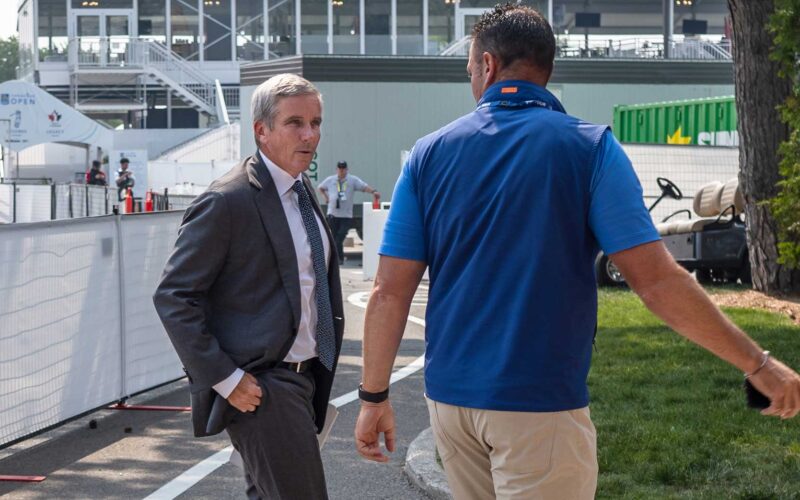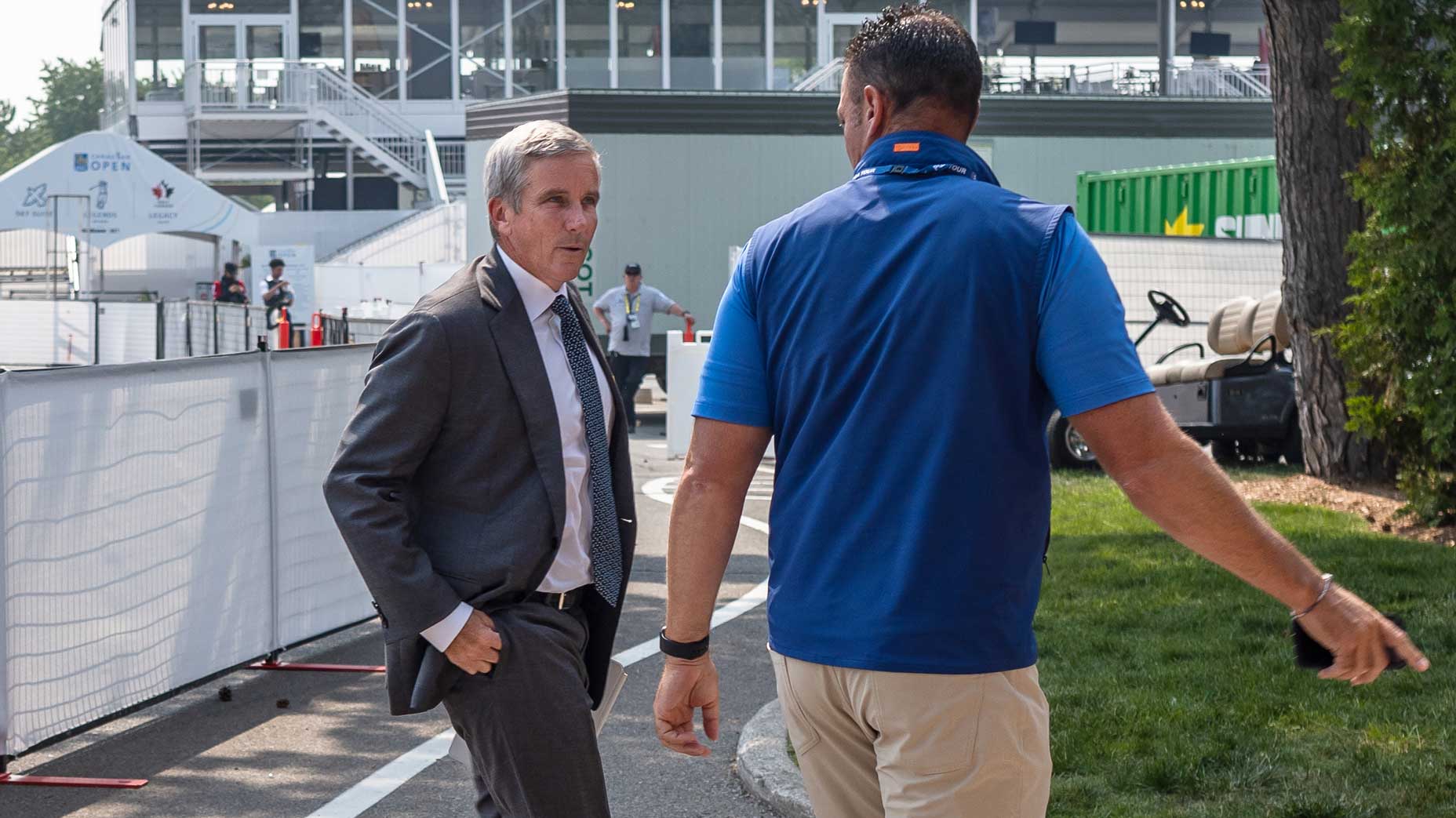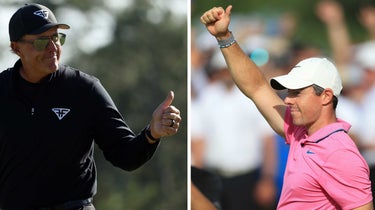A consistent pre-shot routine is a primary key to playing good golf. Here’s a seamless way to incorporate one into your game. The post Simplify your pre-shot routine with these 3 easy steps appeared first on Golf. A consistent pre-shot routine is a primary key to playing good golf. Here’s a seamless way to incorporate…
Here’s how the PGA Tour looked the day after everything changed

It was a wild 24 hours on the PGA Tour. Here’s what it looked like at the Canadian Open, where there are more questions than answers.
The post Here’s how the PGA Tour looked the day after everything changed appeared first on Golf.
It was a wild 24 hours on the PGA Tour. Here’s what it looked like at the Canadian Open, where there are more questions than answers.
The post Here’s how the PGA Tour looked the day after everything changed appeared first on Golf.
TORONTO — On the surface, this was any old Wednesday morning on the PGA Tour. The defending champion, Rory McIlroy, teed off shortly after 7 a.m. in the first pro-am team off the 10th hole, paired with the CEO of the presenting sponsor, the Royal Bank of Canada. The No. 3 player in the world was set to play a breezy nine holes, learning as much as he could about a course he’d never seen before, and then pop into the media center for a press conference. But this was not any old Wednesday.
McIlroy had been at Oakdale Golf and Country Club long after dark Tuesday night, finishing out the last of a number of meetings to discuss the ramifications of the most significant day in modern golf history. For more than a year, the PGA Tour had walked, ran and sprinted in one direction — away from Saudi Arabian investment — only to stop, hop around 180 degrees on Tuesday morning and unexpectedly grab all that Saudi money after all.
McIlroy’s press conference suddenly took on a bucket full of importance. He had stepped in as the Tour’s leading voice, conducting press conferences at every tournament and eloquently explaining the Tour’s perspective, the elite-player position, and why it was wise to stay loyal to the biggest tour in the world. His thoughts on, and involvement in the matter were vital to our understanding of the Tour’s shocking reversal.
First, McIlroy confirmed that he did know about the agreement slightly earlier than most. Jimmy Dunne, an independent director of the PGA Tour Policy Board, had texted McIlroy Monday night and asked to talk in the morning. They spoke at 6:30 a.m. Tuesday, but Dunne could only share the information as he knew it. Which is to say, in a limited capacity.
“So there’s mixed emotions in there as well, as there’s going to be,” McIlroy said. “I don’t understand all the intricacies of what’s going on. It’s a very — what’s the word? — there’s a lot of ambiguity. There’s a lot of things still to be sort of thrashed out. But at least it means that the litigation goes away, which has been a massive burden for everyone that’s involved with the Tour and that’s playing the Tour. And we can start to work toward some sort of way of unifying the game at the elite level.”
If it sounds like he’s uncertain of some things, that’s because he has to be. The partnership/merger/agreement — any of these words seem to do — will become finalized in the next few weeks. But the ambiguity he speaks about has created an odd feeling around the grounds of the Canadian Open: confusion mixed with acceptance. Confusion about the lack of detail and acceptance that it won’t be arriving immediately. There are more questions than answers at this juncture, no matter who you are and no matter who you talk to.
There was predictable chatter early Wednesday about the leadership of PGA Tour commissioner Jay Monahan. “I don’t know how he keeps his job, at least long-term,” one top Tour coach said. Monahan had brokered the deal mostly in private among a small group of people, which he believes was absolutely necessary to get it done and drop the litigation between the PGA Tour and LIV Golf. The hastiness of the deal, the closed-circuit communication and the lack of details shared with the Tour membership has not sat well with players. Some found out via an emailed letter, many found out via Twitter, and then there was the case of Cameron Young, who found out via the CEO of RBC, David McKay, at an off-site event.
The players meeting scheduled for 4 p.m. was the highest attended non-mandatory meeting these players have ever seen. Only one man remained on the driving range when it began — Martin Trainer, joined shortly by Chad Ramey — while a few others elected to rip around a suddenly empty golf course. About 100 pros gathered in the main clubhouse dining room to interrogate Monahan.
In a word, Mackenzie Hughes called the meeting “hostile.” Monahan himself called it “intense. Certainly heated.” Over the course of 75 minutes, Monahan reiterated talking points and begged for patience and trust as he worked to quell a membership that has used the words “blindsided” and “shocked” more in the last 24 hours than ever before.
Harry Higgs asked about the potential for — in a new, for-profit enterprise — Tour members to be given equity stakes in the operation. That certainly piqued interest in the room. Numerous players elevated the point that — beyond the 180-degree turn in mentality regarding Saudi money — the Tour already felt like it was in a position of power in the struggle over pro golf. Did it need more power?
Some of that power, it seems, was rooted in taking “a competitor (LIV Golf) off the board, and turning them into a partner, not an owner,” Monahan told the media. The press release issued Tuesday morning detailed how the commercial operations of the PGA Tour, DP World Tour and LIV Golf would “merge”, with that particular wording bothering McIlroy.
“So I think the one thing that I think was really misconstrued was all the headlines were ‘PGA Tour merges with LIV,’” McIlroy said. “And LIV’s got nothing to do with this, right. It’s the PGA Tour, DP World Tour and the Public Investment Fund are basically partnering to create a new company.”

What will come of LIV Golf remains to be seen, but its outlook has certainly changed. Monahan says there will be an “empirical evaluation” of LIV, its assets and its version of team golf. The majority of that is set to take place over the next few weeks. But one thing is clear, LIV is no longer an opponent, both in hosting events or the court room.
The binding aspect of the agreement was calling an end to all litigation between the fighting tours, effective immediately. Many Tour executives had already been, or were in line to be, deposed. The same could be said for LIV golfers, LIV executives and some of the game’s most powerful agents. The discovery process of the lawsuits was held up in various appeals to keep Saudi officials from speaking on the record and sharing documents of LIV Golf’s creation. Much of what was assembled by each team’s defense is now (and perhaps forever) locked in redacted court documents.
Any Tour pros following the meeting in a silent manner were dwarfed by a raucous majority deeply upset with Monahan. Numerous players stood up from their seats to tell him they cannot trust him anymore. Grayson Murray was one of the most vocal, outright telling Monahan that he needs to resign. Murray hadn’t wavered from that mindset Wednesday afternoon, saying, “I’m not necessarily pissed off with what has transpired, it’s more just how it’s been handled with Jay and everyone. That’s why I said what I said. He should resign. We need a fresh face.”
According to multiple players who were in the room, a contentious back-and-forth between Murray and McIlroy wasn’t quite as serious as it may have been initially reported, but important notes were struck. Murray contended that McIlroy was jealous he didn’t take money he was offered by LIV. McIlroy stated he was content with his current status. It ended in McIlroy telling Murray to “play better,” a line that apparently wasn’t appreciated by the rest of the room.
McIlroy maintains he was not offered any money by LIV, as he said Wednesday. Murray said he believes McIlroy has received some sort of payment “under the table” during this last year. Details of multi-million dollar LIV offers have once again become constant fodder recited by players, caddies and coaches, just like last summer when real offers were being accepted, but no one is in a rush to verify the offers themselves.
By the end of Tuesday, McIlroy and Murray were not at each other’s throats, as may have been portrayed. After about 75 minutes, the room began to disperse and Monahan was off to conduct a virtual press conference with media. McIlroy and Murray found themselves seated near each other in a smaller group of about 25 players discussing the issues for another extended period of time. McIlroy congratulated Murray on his recent win and any lingering awkwardness was squashed, in part, Murray said, because the remaining group wanted to pick McIlroy’s brain for anything else he could share.
After meeting with the press for about a half hour, Monahan’s next appointment came with the Tour’s Advisory Council, a group of 16 Tour members who serve as a collective representation of the Tour membership and elevate issues to the policy board for final votes. One of the core focuses of the hour-long PAC discussion — which was virtual and already planned before the news broke — was how to fairly and properly reintegrate golfers who left the PGA Tour for LIV Golf and its riches.
“There still has to be consequences to actions,” McIlroy said of the topic on everyone’s mind. “The people that left the PGA Tour irreparably harmed this Tour, started litigation against it. Like, we can’t just welcome them back in. Like, that’s not going to happen. And I think that was the one thing that Jay was trying to get across yesterday is like, ‘Guys, we’re not just going to bring these guys back in and pretend like nothing’s happened.’ That is not going to happen.”
The process of answering that question typically raises another popular question on-site: How does the Tour make whole the players who passed on tens and even hundreds of millions of dollars in LIV contracts over the past 15 months? Many of those players were part of the 22-person Delaware meeting that Tiger Woods, McIlroy and Co. organized back in August. Monahan’s next meeting came with various members of that group as the sun set on this week’s host site. It becomes easy to understand how McIlroy didn’t leave the course until 9:30 p.m. When Monahan left the course Tuesday evening is unclear but he was back there early Wednesday morning, moving from table to table in player dining, answering more questions and pressing skin with the membership he says he is in a position to serve.
“I can’t imagine how he’s sleeping tonight,” Hughes said in a sympathetic tone Tuesday night. “Or how he slept last night, knowing this was all going to come out. And just having to face all these questions and the criticism. It’s just going to take a toll on you.”
It is certainly an uphill battle for Monahan to win back the trust of the Tour membership, but he will do so as the CEO of the to-be-named company. He will continue to be asked about 9/11 rhetoric that he wielded at various points in 2022, his first public answer coming today in a fumbled response on Golf Channel.
Monahan will also face a stern look from antitrust regulators and, as of Wednesday afternoon, democratic senators. Connecticut senator Richard Blumenthal shared the following statement: “The PGA Tour has spent two years lambasting Saudi sports-washing and paying lip service the integrity of the sport of golf, which will now be used unabashedly by the Kingdom to distract from its many crimes. The PGA Tour has placed a price on human rights and betrayed the long history of sports and athletes that advocate for social change and progress. I will keep a close eye on the structure of this deal and its implications.”
Players are no doubt aware of the hypocrisy their tour will now be labeled with, and many may still be uncomfortable with where the money comes from. But a certain reality has taken over. You could see plenty of that in McIlroy’s answers Wednesday morning, where he admitted to feeling like a “sacrificial lamb” for all he’s said on behalf of the Tour in the last 12 months, only to have things change so abruptly.
While Monahan conducted that Golf Channel TV interview, his fellow Tour exec Andy Pazder met with pros in player dining, and player-relations head Jason Gore bounced between conversations with other pros at the front of the clubhouse.
At the far end of the property was Ben Crane, rehearsing his swing as he waited for a spot on a packed driving range. Crane was reportedly an outspoken member at the player meeting, but when prompted to share his thoughts with about 20 hours of hindsight, he paused between swings and said, “I don’t know… yet,” and then kept swinging.
Maverick McNealy took to social media with a 500-plus word post that stressed patience. “I do not want to answer any more questions about this,” McNealy wrote. “I know so little. And I think further discussion of this will only hurt the Tour and our goals for this week.”
“Still a lot of unknown,” was the similar tune, offered by Justin Thomas via text. “Trying to keep an open mind toward all of it and truly let stuff play out. Who knows what may happen.”
It might be the only point to make right now. Who knows what may happen? Tuesday offered a blunt strike of that truism. The soundest mind of the day may have been that of Adrian Rietveld, a TaylorMade Tour rep who walked along with McIlroy in the pro-am and was in no rush to make any conclusions at all. “It’s all going to be based on assumption,” he said. “Anyone that says anything today is working off assumptions. We know so little.”
Rietveld stressed that there’s nothing to do but wait. And for the moment he seems absolutely right. Wait, and play the first round of the Canadian Open, which conveniently arrives Thursday morning. And after that, wait some more.
The post Here’s how the PGA Tour looked the day after everything changed appeared first on Golf.

